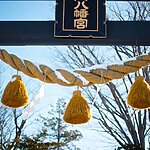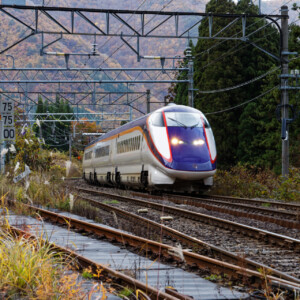
Introducing popular temples and shrines recommended for the first visit to the New Year of the Year of the Snake (Yamagata Prefecture)!
table of contents
When it comes to New Year's visit in Yamagata Prefecture, there are temples and shrines all over the prefecture that are visited by many worshipers, such as Yamagata Gokoku Shrine and Tateishokuji in Yamagata City, Uesugi Shrine in Yonezawa, Kameoka Monjudo in Takahata, and Kumano Taisha in Nanyo.
In this article, we will introduce three unique shrines that are closely related to the zodiac sign of 2025, the snake, as recommended New Year's visit destinations in 2025.
Dewa Sanzan Shrine (Tsuruoka City)

Dewa Sanzan, located in the center of Yamagata Prefecture, has long been known as one of Tohoku's most representative sacred sites, and has been worshiped as one of Tohoku's most sacred places in Shugendo, which goes around the three mountains.
Each of the three mountains is worshiped as a god: Mt. Gassan is the god of the past (we pray for peace after death), Mt. Haguro is the god of the present (we pray for happiness in this life), and Mt. Yudono is the god of the future (we pray for reincarnation). It is said that

However, due to heavy snowfall in winter, Mt. Gassan and Mt. Yudono are closed, so the three shrines of Dewa Shrine, where the three gods are said to be enshrined, were built on the summit of Mt. Haguro, which can be visited even in winter.
the Dewa Sanzan Shrine Sanjin Gosaiden, you will have visited the three mountains, so it is a power spot recommended for New Year's visits.
Enshrined deities and benefits at Dewa Sanzan Shrine Sanjin Gosaiden

The deities enshrined in each of the three mountains are as follows.
- Gassan (Gassan Shrine): Tsukuyomi
- Mt. Haguro (Dewa Shrine): Ideha no Kami, Inakura Tama no Mikoto (Ukanomitama)
- Mt. Yudono (Yudonoyama Shrine): Oyamazumi no Kami, Oanamuchi Mikoto, Sukunahikona Mikoto

These gods bring various benefits such as ``abundant harvest,'' ``prosperity in business,'' ``good catch,'' ``good health,'' ``safety at home,'' ``matchmaking,'' ``easy childbirth,'' and ``pleasure for all.'' You can receive the following.
In addition, one of the deities enshrined at Dewa Shrine, Inakura Tama-no-Mikoto, is Inari Daimyojin, or Inari-sama, which is also known as Ukanō Otama-kami.
This Inakura Tamamikoto sometimes appears with a white snake on its head, and is a god deeply related to the " Dragon and Snake Faith " introduced at Suwa Shrine, so it can be said that it is a god connected to the Year of the Snake. Sho.
New Year's visit information for Dewa Sanzan Shrine Sanjin Gosaiden
The main shrine can be visited from December 31st to January 1st from around 17:00, on the 2nd from 6:30 to 17:00, and from the 3rd onwards from 8:30 to 17:00, and the presentation of amulets etc. is at 9:00. It is scheduled to run until 4:30 p.m.
The Matsureisai, a fire festival on Mt. Haguro that brings good fortune, is held from New Year's Eve to New Year's Day, followed by the Saitansai Festival from 3 o'clock on New Year's Day, and the Genshisai Festival from 10 o'clock on January 3rd. It will be held.
Dewa Sanzan Shrine Sanjin Gosaiden <Information>
- Facility name: Dewa Sanzan Shrine Sanjin Gosaiden
- Address: 7, Tamukahaguroyama, Haguro-cho, Tsuruoka City, Yamagata Prefecture
- Phone number: 0235-62-2355
- Awarding office and stamp office reception hours: 8:30-16:30
- Prayer reception: 8:30-15:45
- URL: Dewa Sanzan Shrine official website
GOOGLE MAP
Toyoryu Shrine (Asahi Town)

This shrine, located in the middle of Yamagata Prefecture, has a long history, and in 844 (Jowa 11), when Ankei, a monk from Enryakuji Temple on Mt. Hiei in Kyoto, came to Asahi Town to give a lecture, he enshrined the dragon god that appeared in his dream and built the shrine. It is said that it was built.
Not only is the shrine enshrined a dragon god, which is rare in this region, but it is also unique in that a `` yakuzai prayer '' is held to sever misfortune, misfortune, illness, bad luck, etc. using the sacred sword that has been passed down from generation to generation.

Additionally, within the precincts is a large cedar tree that is designated as a natural monument by Yamagata Prefecture.This large cedar tree with a diameter of 7.5 meters has protected the shrine as a sacred tree where a white snake lives .
Asahi Town is close to Yamagata City, and why not visit Horyu Shrine, which enshrines a dragon that is said to be inseparable from snakes, and pray for good luck in 2025, the year of the Snake.
Enshrined deity and benefits of Toyoryu Shrine

Toyotama Hime no Mikoto is said to be the daughter of a sea god and is deified as a dragon god, and is affectionately known as "Ryujin-sama."
For over 1,200 years, this god has bestowed blessings on people, such as rich harvests, safe childbirth, childbearing, prosperity of descendants, marriage, fulfillment in love, and safety at sea.
In addition, the ``Art Goshuin'' created in collaboration with Yuko Yamaguchi, a Japanese painter who lives in the local Asahi Town, is popular, and in 2025, the motif is a white snake that is said to live in Osugi, which is said to bring great happiness. Masu.
New Year's visit to Toyoryu Shrine

Gifts such as stamps and amulets, as well as prayers, are accepted from 9:00 a.m. to 4:00 p.m., but please check the shrine's official website for reception hours during the year-end and New Year holidays before heading out.
The shrine also has free parking.
Toyoryu Shrine<Information>
- Facility name: Toyoryu Shrine
- Location: 1203-1 Miyajuku, Asahi-cho, Nishimurayama-gun, Yamagata Prefecture
- Phone number: 0237-67-2236
- Awarding office reception hours: 9:00-16:00
- Prayer reception: 9:00-16:00
- URL: Toyoryu Shrine official website
GOOGLE MAP
Suwa Shrine (Yamagata City)
There are said to be approximately 25,000 Suwa Shrines across the country, with Suwa Taisha Shrine in Lake Suwa, Nagano Prefecture as its headquarters, and one of them, Suwa Shrine, which celebrates its 550th anniversary this year, is said to be the oldest shrine in Yamagata City.
It is said that in 1474 (6th year of Bunmei), when this region was suffering from drought, the lord of the castle had a dream, and as he had said, he built Suwa Shrine and prayed for rain, and it rained.
It is said that eggplants were the first crops harvested after a rain, so at the annual festival at Suwa Shrine, worshipers offer five eggplants and take two home to eat as a blessing to the gods. It is said to have divine protection.
Suwa Shrine’s enshrined deity and blessings

The main deity enshrined is Takeminakata no kami, known for the myth of ``kuni yuzuri'' (taking over the country), and his older brother, Okuninushi no kami, who is said to be the parent deity. This is Kotoshironushinokami.
In addition to being the guardian deity of agriculture, commerce, and industry, it is said to have the blessings of ``prolonging life and warding off evil spirits,'' ``praying for victory,'' and ``bringing good luck and longevity.''
Due to the ``Dragon and Snake Faith,'' which views Takeminakata no Kami as a dragon or a snake, there are many legends and folk tales in which this god appears as a dragon or a snake, so great blessings are expected in 2025, the Year of the Snake. I am.
Additionally, within the grounds of Suwa Shrine, there are Fukurokuju Inari Shrine, which is considered one of the Seven Lucky Gods of Yamagata, and Fugen Shrine, whose object of worship is Fugen Bosatsu, who is known as the guardian principal image of the Year of the Dragon and the Year of the Snake. I am.
For these reasons, Suwa Shrine, where you can expect the power of ``Dragon and Snake Faith'' and ``Guardian Principal Image,'' is recommended as a New Year's visit destination in 2025.
Suwa Shrine New Year’s visit information
On the third day of the New Year, a bus will be running between Yamagata Station and four shrines in Yamagata City.
Recommended for people who want to avoid crowded parking lots or who are worried about driving on snowy roads.
The route departs every 45 minutes from 9:00 a.m. and visits Fyoretsu Shrine, Satonomiya Yudonoyama Shrine, Yamagata Prefecture Gokoku Shrine, and Suwa Shrine before returning to Yamagata Station. 100 yen per ride (junior high school students) Free of charge below).
Suwa Shrine<Information>
- Facility name: Suwa Shrine
- Address: 1-1-55 Suwacho, Yamagata City, Yamagata Prefecture
- Phone number: 023-622-6358
- Awarding office reception hours: 9:00-17:00
- Prayer reception: 9:00-17:00
- URL: Suwa Shrine official website
GOOGLE MAP
summary
In this article, we introduced three unique shrines in Yamagata Prefecture as recommended New Year's visit destinations, but in addition to these, there are other shrines and temples that are deeply connected to the Year of the Snake.
It's good to visit famous shrines and temples as a standard, but if you research the history and blessings of those shrines in your neighborhood, you may discover some surprising things.









![Introducing popular temples and shrines recommended for the first visit to the New Year of the Year of the Snake [Iwate Prefecture]! Iwate Catch](https://jp.neft.asia/wp-content/uploads/2024/12/077d99f4a92a0a35be153e3c80aefe9a-150x150.jpg)




!["Mogami safflower" certified as a Japanese heritage and Japanese agricultural heritage [Yamagata Prefecture] Mogami safflower](https://jp.neft.asia/wp-content/uploads/2022/12/30121446_m-1-150x150.jpg)

![[Tsuruoka City, Yamagata Prefecture] Tsuruoka's food culture has been passed down for hundreds of years 1470_Zenpoji Temple](https://jp.neft.asia/wp-content/uploads/2023/04/2d6b75e2500adfb8f7b8e6c68a2f7a03-150x150.jpg)











